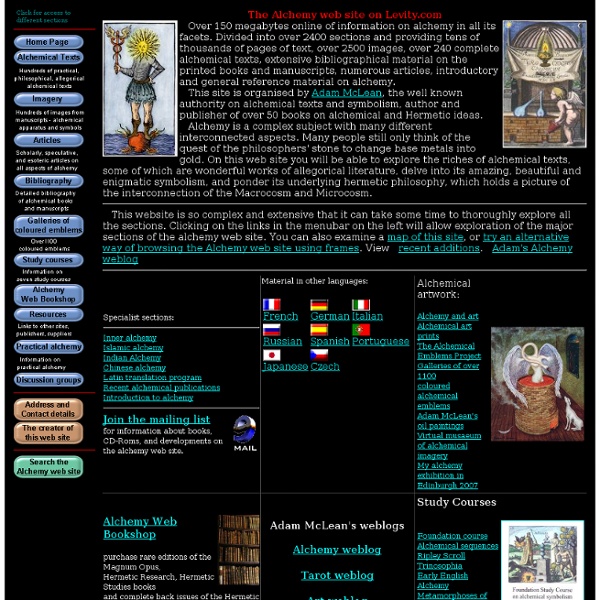



The Alchemist's Cookbook Fire! Earth! Wind! Water! No, this isn't another bad episode of Captain Planet. These four forces of nature from the Greek were once connected in a system of beliefs and rituals known as alchemy. Alchemy was a philosophy that investigated the mysteries of life, specifically inanimate objects of nature. The substance they believed that would transmute lead into gold was known as The Philosopher's Stone. There were also connections between days of the week, planets, and metals, as follows, The days of the week were named after the planets: Sunday for the Sun, Monday for "mooneday" (old English), Tuesday for Tyr (Mars), Wednesday for Woden (or Odin, Mercury), Thursday for Thor (Jupiter), Friday for Frigga (wife of Mercury), and Saturday for Saturn. Accordingly, different chemicals processes were associated with the 12 signs of the zodiac, Alchemists also used images of serpents. A three-headed serpent represented the Philosopher's Stone. References: 1. TAlC/bc
infinite alchemy Magical Wood Properties and the Magical Properties of Wood by DragonOak Feminine energy. Elder is a sacred tree of Celtic Astrology 25 November to 23 December. The Elder is also said to be the tree used in the crucifixion of Christ. Associated with the Celt Goddess Cailleach Beara and the Raven. Some have considered this tree to be unlucky due to its association with the crucifixion, or it may one of those nasty rumors started by the church in order to combat belief systems outside their on scope of a limited belief system. Magical Properties: Elder wands are most often used in Faerie Magic, banishment, magical arts, protection from evil, imagination, change, and healing. Feminine energy. Magical Properties: Use of the Elm wands is strong in magic used concerning endurance, fertility, horticulture, passage thru death and phases of life, rebirth, and invocation of the Goddess. by DragonOak| Masculine energy. by DragonOak| Feminine energy. Magical Properties: Artistic ability, magical knowledge, and optimism are provided by the enchanting use of Hazel.
The Birds in Alchemy by Adam McLean The Alchemy web site on Levity.com This article written in 1979 was first published in the Hermetic Journal No. 5. In alchemical writings we meet a seemingly bewildering multiplicity of animal symbols - red lions, white eagles, stags, unicorns, winged dragons and snakes. Although at first glance all this complex mass of symbolism seems tortured and confused there is an inner coherence to these symbols, which the ancient alchemists used in specific ways reflecting their esoteric content. In this article I wish to consider a particularly tight knit group of these animal symbols, the birds of alchemy - the Black Crow, White Swan, Peacock, Pelican, and Phoenix - which are descriptive of certain stages of the alchemical process. Of course it would be wrong to suggest that there are fixed rigid meanings with regard to these symbols. The Black Crow sometimes also the Raven is the beginning of the great work of soul alchemy. The next stage, is often shown as The White Swan.
Reformed Druids of North America Homepage Symbols in books of alchemy Sources: Wd1426, Wd1421A, Wv149, Ws2541A Wd1426, a book of alchemical recipes, has caused us to add some additional symbols to our inventory of character entities: signs for substances antimony and sal armoniac; the elements fire and water; and the syllabics "subli-" and "precipi-" (found in sublimate, precipitate, etc.). We've also gone ahead and added the elemental symbol for earth, on the assumption that it will eventually appear in our books as well. The new symbols will soon (March 2002) appear in the latest online version of the primary keying instructions as reproduced below. (Examples of the symbols in context follow further on below.) Addendum, June 2002: Wd1421A employs the same set of symbols. Addendum, February 2003: Wv149 adds symbols for sulphur, oil, and ? Addendum, December 2003: added two symbols found in a strange non-chemical book Ws2541A, viz. salt and saltpetre Addendum, Sept 2011: added some symbols from a chart of abbreviations from WB1088 Some sample transcriptions
Rune Meanings - The Elder Futhark I work with the "Elder Futhark", the runic alphabet which is a composite of the runic symbols most commonly used in northern Europe. The names of the runes of the Elder Futhark are speculative recreations of what linguists call "proto-Germanic", which stems from "proto-Indo-European". There are many versions of the runic alphabets. The runes are broken into three sections or groups of eight, called aett (aettir, plural). First the rune name is given, then its phonetic value, its symbolic image, and finally the esoteric meaning used in divination. Fehu(F: Domestic cattle, wealth.) Uruz: (U: Auroch, a wild ox.) Thurisaz: (TH: Thorn or a Giant.) Ansuz: (A: The As, ancestral god, i.e. Raidho: (R: Wagon or chariot.) Kenaz: (K: Beacon or torch.) Gebo: (G: Gift.) Wunjo: (W or V: Joy.) Hagalaz: (H: Hail.) Nauthiz: (N: Need.) Isa: (I: Ice.) Jera: (J or Y: A year, a good harvest.) Eihwaz: (EI: Yew tree.) Perthro: (P: Lot cup, vagina.) Algiz: (Z or -R: Elk, protection.) Sowilo: (S: The sun.)
9-2 (2003): Visualization in Medieval Alchemy Barbara Obrist* Abstract: This paper explores major trends in visualization of medieval theories of natural and artificial transformation of substances in relation to their philosophical and theological bases. The function of pictorial forms is analyzed in terms of the prevailing conceptions of science and methods of transmitting knowledge. The documents under examination date from the thirteenth to the fifteenth century. In these, pictorial representations include lists and tables, geometrical figures, depictions of furnaces and apparatus, and figurative elements mainly from the vegetable and animal realms. 1. Visualization in medieval alchemy is a relatively late phenomenon. The notion of visualization includes a large spectrum of possible pictorial forms, both verbal and non-verbal. Figure 1: Venise, Biblioteca nazionale Marciana, ms. gr. 299, fol. 188v (tenth to eleventh century). Figure 2: Nürnberg, Germanisches Nationalmuseum, ms. 80 061, p. 158 (ca 1420). 2. 3. 4. 5. 6. Notes
Ár nDraíocht Féin: A Druid Fellowship